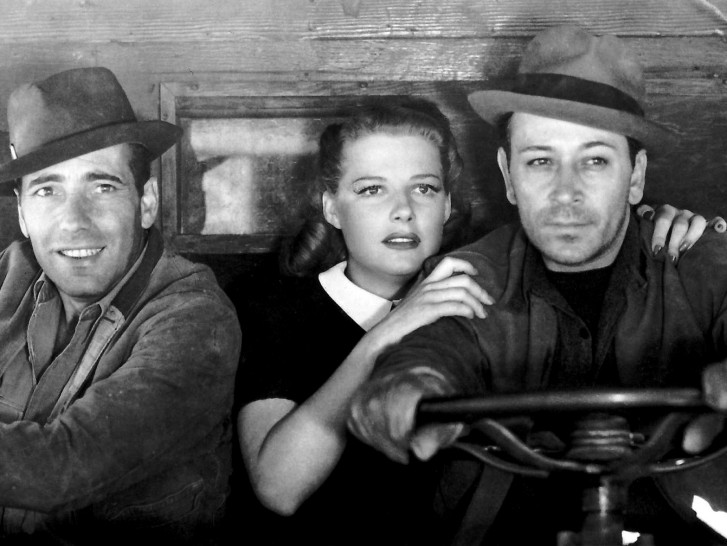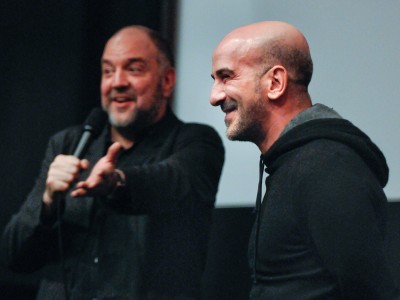
They Drive by Night with introduction by Tom Conley.
Transcript
John Quackenbush 0:01
February 1, 2013, the Harvard Film Archive screened They Drive by Night. This is the recording of the introduction by Harvard Professor Tom Conley.
[APPLAUSE]
Tom Conley 0:17
Thank you, thank you. Thank you so much, Haden. In fact, you're the generator here. Apropos of generators, we're gonna see a lot of generators and manpower later on this evening. But it's an absolutely stunningly rare pleasure for me to be here and do this, and there are many autobiographical motivations here, but generally, the use of the first-person singular tends to be odious, so I will refrain from that. But I would like to say, too, that since I've been at Harvard University, the greatest invention that it has here, that it has not patented but that is here and with us, is Haden Guest. Because he has done wonders for the HFA and its programming. He's brought brilliant insights to just panoply after panoply of films and directors. And he is a person of boundless knowledge of cinema, and has this incredibly rich memory bank of images that, in effect, makes him one of the greatest cinephiles that I have ever known. And I can see how he would the, let’s say, the classical definition of the cinephile, which I can use as a transition here for the way that we may be appreciating the work of Raoul Walsh. And I would just start by citing Douglas Gomery, I think, long ago, who said, “Anyone who wants to know anything about Hollywood cinema has to cross by, or follow the career of Walsh himself,” because he, in effect, did work with Griffith in New Jersey, in fact, before Griffith in New Jersey, shooting one-reelers in Fort Lee and Englewood. And then he went with Griffith, Biograph, and then, of course, we know that his first great role in a film was, was that of John Wilkes Booth in Birth of a Nation. And it was then that he, in fact, was one of the great forces behind silent cinema. And he made the great transition into the sound era. And of course, by the time he was done, he had either acted in, or shot, or revised,or worked upon 176 films. So he's in that same stature as John Ford whom we know.
But much of this can be obtained in a wonderful new biography of Walsh that has been done by Marilyn Moss, the University of Kentucky Press. And she has really sorted through a lot of the material, and it's a nice point of reference for the history of Walsh as a director and as a mythomaniac at the same time. Because of this mythomania we're going to see almost percolating through all of the films, to wit, in the film we'll just be seeing in a few minutes, in They Drive by Night, it's not by chance that Walsh's cinema is obsessed by issues of ocularity, and of insight and blindness, for the fact that he lost an eye, his right eye, when he was acting in the film he was directing in 1928, In Old Arizona. In fact, it ended his career as an actor and then launched him as a great, great director, but we will see how this ocularity is going to run through this film. But you even see it before he loses his eye because of the eye-patched villain in Regeneration, that great film of 1915 that we showed a couple of days ago in VES 183, which is Auteur Theory that, in effect, is working with the cinema of Walsh. Because it can be argued that Walsh, and now I'm going to move from the biographical side, the historical side, that I think is characteristic of the American appreciation of Walsh to the one that is more in the French tradition, in the auteurist tradition. Because Walsh is an auteur for the reason that his films are part of the industry, as it rolls In effect, it’s just built on one cliché after the other, at the same time that there is a signature that, in effect, runs through these. And I’ve tried to delineate a few of those in the program notes. But it is from that perspective that if you go to Paris, you'll see that Walsh is, in fact, lionized there as one of the great and seminal directors. In fact, he is idolized by Bertrand Tavernier, our colleague. He's the subject of numerous studies that work from a perspective that is quite—let’s see, how should I say?—it's more inductive; it works through the great French analytical tradition of close reading than a biographical one. In effect, I’d like us, in effect, as we follow this wonderful, wonderful retrospective, and with great prints that we have before us, to in fact, engage these two sides of Walsh's work that has a constant effect of a signature that's behind it, at the same time that it is part of a great common basis that is forming it. And that's what forms the auteur. The auteur, in effect, is both common money and it is something else at the same time. And I think we'll see this as we work cumulatively through the films.
I’ll just make one other note here, before we get started, for the younger viewers in this audience. And that is that when we see one of the great sequences in They Drive by Night—it’s one of the most delicious sequences—it takes place in the most clichéd, in the most banal of all places. It's sort of a locus classicus in Depression cinema, and it's the diner. We know the diner from I Was a Fugitive from a Chain Gang. We know the diner from Sullivan's Travels. But we see diner after diner. We get into this diner, where, I believe, Joe Fabrini is George Raft, with Humphrey Bogart. Their truck has broken down, and they've got to get it repaired. And so they barge into this place that's filled with truck drivers, sitting around their seats. And this stunningly beautiful waitress who, in effect, struts up and down the aisle and catches the glances of every one of the truck drivers ogling at her. She is addressed by George Raft, who, in effect, has to make a phone call. And so he says, “Give me a Frisco phone book!”. And she, then, in a typical visual of Walsh, hands the phone book across the counter to him and says, “Yeah. Here it is. And give it back to me with all the pages.” And so younger people, who, in effect, are going now into the paperless world of everyday life, would not recognize the fact that both the Sears Roebuck and the phone book, in effect, are essential elements of the toilet in the Depression. You will see, in effect, these moments all through the films that break down the mimetic illusion. Again, all we have to even think of is the same sequence, when they locate the donut jar that is in the foreground. And we'll see what the relation of the donut jar is to Ann Sheridan’s body. And we'll see further, in effect, one line after the other, where one of the drivers says, “Oh! Classy chassis, Cassie!” Her name is Cassie. And then she turns about and she says, “Yes! It is all mine. And you couldn't even afford the headlights.” [LAUGHS] So this comedy, in effect, then is going to move at the same time into film noir, and then the film is going to go all over the place, and we'll get one of the most stunning performances and visually capturing performances of Ida Lupino, who goes crazy over the vision of an electric eye. In effect, she goes into this state, “The doors did it! The doors did it!” And, what becomes pathos, and just psychodrama, then is going to shift into comedy at the end. So you're going to get these extraordinary movements from one register to the other in the films, done within a highly filmic fashion of the kind that Haden just suggested to us in his introduction. So without further ado, let's retrospect! [LAUGHS] Thank you very much.
[APPLAUSE]
©Harvard Film Archive
Related film series
Explore more conversations
Whit Stillman

Rabah Ameur-Zaïmeche

Tsai Ming-liang, Lee Kang-sheng & Anong Houngheuangsy

Kivu Ruhorahoza

